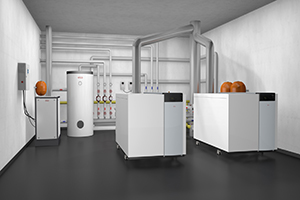Marginal gains to bold leaps

In the world of commercial boilers, the traditional rules of engagement are well documented: Manufacture a highly efficient unit that meets the expectations of the market, remove the old product from the range and sing the virtues of the new model’s features. It has been a successful strategy for many years, with incremental improvements delivering major developments over a decade.
However, there haven’t been many leaps in performance that allow one floor standing condensing boiler to stand out from another. Will this always be the case for commercial gas condensing boilers, or can this well-established industry push the envelope further?
To answer, it’s important to look at what needs improving. There are some key factors that establish a boiler’s level of performance and the first is efficiency. New gas condensing boilers might not have shown much improvement in headline figures over the years, but that’s because eking out an extra percentage point is becoming ever more challenging for manufacturers. As a result, it’s more important for specifiers to consider lifetime efficiencies as the more accurate determination of a unit’s performance.
Lifetime efficiencies
 |
|
Technical advances: a water-cooled flame burner and optimised combustion zone for low emissions |
Gauging these usually relies on analysis of the heat exchanger – a component that is put under extreme stress from the first minute a burner is fired. Consequently, the choice of material the heat exchanger is manufactured from becomes critical, not only for its short-term performance, but also for the next 10 to 15 years of its life.
These days, stainless steel is often the preferred material for heat exchangers by both boiler manufacturers and specifiers alike. And that’s mainly due to the confidence of knowing a stainless steel heat exchanger’s published performance figures are consistent for its entire operating cycle, which cannot be said for alternatives. Other metals have been shown to significantly drop in efficiency over their lifetimes due to the effects of gradual corrosion.
This is often very apparent when looking at an ageing aluminium heat exchanger, for instance, where dissolved sulphuric and nitric acids have corroded the heat exchanger material on the flue gas side, leaving its surface pitted and unable to cope with the tough environment of a commercial heating system. However, these problems can’t be found with stainless steel, as the metal has an inherent resistance to corrosion. Consequently, it doesn’t suffer over its lifecycle, easily coping with the demanding conditions inside a boiler’s hydraulic system.
System flexibility
So, will we see a leap in boiler efficiencies anytime soon? Probably not, at least when it comes to a single unit. Instead, the potential for greater advances lies in combining gas condensing boilers with other technologies. The latest commercial heating systems often include multiple heat sources, such as solar, heat pumps and CHP units.
As a result, systems are becoming more complex and heavily reliant on efficient heat distribution throughout a building. These demands require accurate hydraulic balancing, which is usually best achieved using a low loss header or buffer. However, these systems also demand a degree of flexibility and reaction time from integrated heat sources.
One way of providing this flexibility is to use gas condensing commercial boilers that use low water content technology. These respond rapidly, even in complex installations combined with other heat sources. This makes them a more practical option, and can reduce utility costs. Switching to this can provide a drop in heat up times, with a high water content boiler* taking up to 280 seconds from cold condition to standby temperature, while a comparable low water content unit boiler needs just 30 seconds.
Rising outputs
It’s also worth examining the outputs available from individual gas condensing units. This has always been an important for commercial applications where floor area is at a premium. Over the last five years or so, floor standing units have been limited to the 1.8MW mark – certainly when considering a single premix boiler.
 |
| The latest boiler technology for a range of applications |
However, the latest models to enter the market, such as those from Elco, have taken this ceiling to new heights, which means reaching an impressive 2MW output from a single unit. Having this capability often justifies having fewer boilers in a plant room, which consequently allows a facility to significantly reduce ongoing servicing and maintenance costs. Plus, with the latest high output units still offering excellent modulation ratios, there is also the turndown capabilities required within a modern system.
Finally, a more complex and increasingly critical aspect of boiler system design is the flow and return temperature differential. For gas appliances to condense properly and extract the maximum waste heat from flue gases, they need to have a return temperature below around 55oC.
Great potential
This has become more prominent in the commercial boiler market, with building services engineers looking to optimise running costs by increasing the temperature differential, while reducing flow rates and lowering pump operating costs. Consequently, it is important to consider the flow and return temperature differential of a commercial boiler at the specification stage, with a ΔT of 30K offering the most impressive capabilities.
Over the last decade, improvements have been marginal. But there is still the potential to make great strides with gas condensing boiler technology – which is a positive reflection of the industry and a reassuring message.
*Calculation is based on a reference project with 800kW power.
Mark Ferris is specification manager for ELCO Heating Solutions The latest boiler technology for a range of applications







